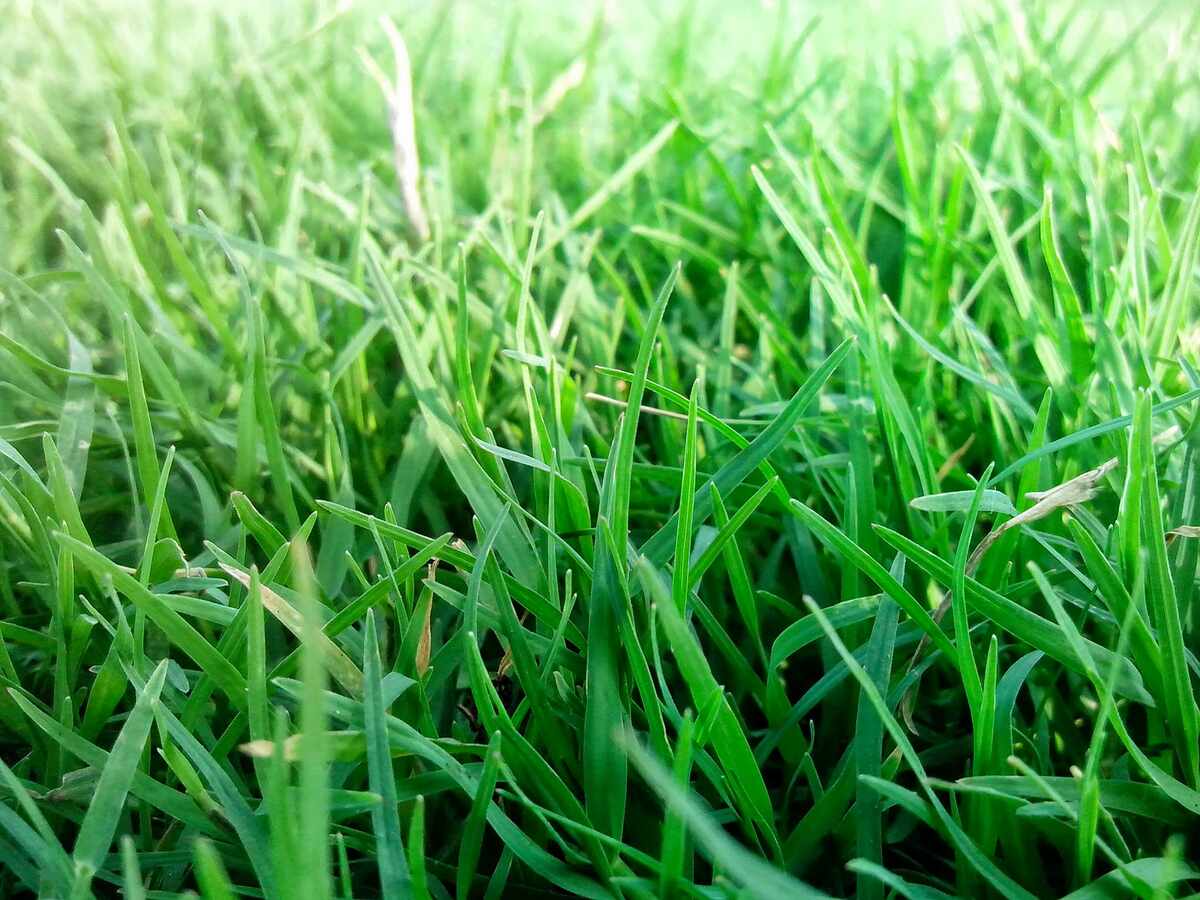
Is your RVA lawn in need of a makeover? Because it lies within the transition zone, the best grass type for Richmond, Virginia depends more on your lawn than on the climate, but we’ve got the six grass types that work best. Both warm- and cool-season grasses will work here, but our cold winters and hot, dry summers make maintaining either grass type a real challenge.
Richmond is located between Virginia’s coastal plains and Piedmont. The open waters of the Chesapeake Bay, the Atlantic Ocean to the east, and the mountain barrier to the west are responsible for the warm, humid summers and relatively mild winters. The area receives precipitation throughout the year with dry spells being most common during the fall season.
Cool-Season Grasses
Cool-season grasses thrive in temperatures between 60–75 degrees Fahrenheit and have the highest growth rates in the early spring to early summer and late summer to early winter. During the heat of the summer, cool-season grasses go dormant unless they are given supplemental irrigation.
These types of grasses do their best work in the hill and valley regions of the southwest, the Shenandoah Valley, and northern Virginia. Establishing cool-season grasses in the spring is possible, but the best time to establish your lawn is in the fall.
Tall Fescue
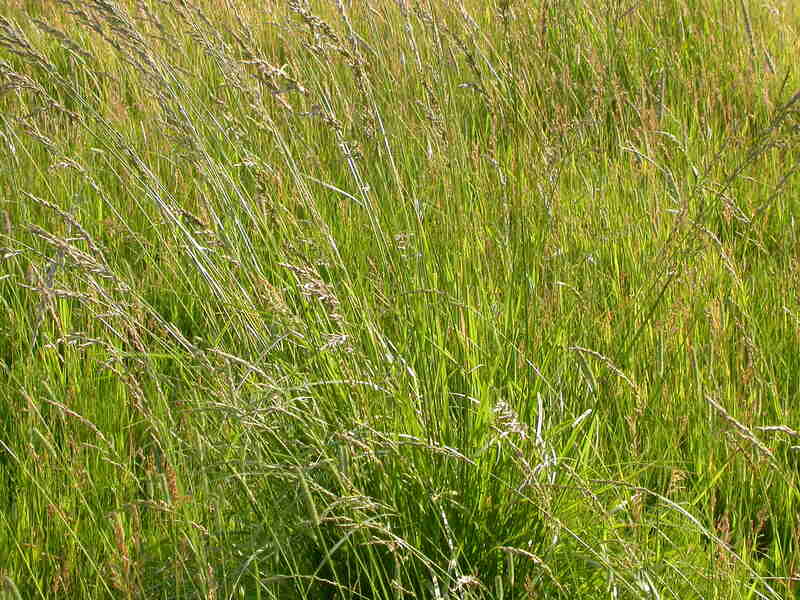
Photo Credit: Matt Lavin / Flickr / CC BY-SA 2.0
Tall fescue is the most common grass in the state but tends to struggle with extreme summer temperatures in the southern Piedmont and Tidewater regions. Despite this, tall fescue is still considered the hardiest and best-adapted grass in the state. There are a myriad of different blends and cultivars that are selected for features like finer leaf density or higher plant density.
Out of all the cool-season grasses, tall fescue has the deepest root system. This allows it to dig deeper into the soil, which helps its drought tolerance. In addition, tall fescue performs best in full sun to moderate shade. Consider tall fescue if you are a homeowner looking for a low- to moderate-maintenance lawn.
- Classification: Cool-season
- Spreads by: Bunch-type grass
- Shade tolerance: Moderate; this grass thrives in direct sunlight
- Drought tolerance: Moderate
- Foot traffic tolerance: Moderate
- Maintenance needs: This grass grows fast; will need to mow often
- Mowing height: 3-4 inches
- Potential for disease: Low
Grass Seed Options:
– Triple-Play Tall Fescue Grass Seed Blend (5000 sq ft)
– Eretz Kentucky 31 K31 Tall Fescue Grass Seed (choose your size)
– Pennington The Rebels Tall Fescue Grass Seed Mix (7 lb.)
Kentucky Bluegrass
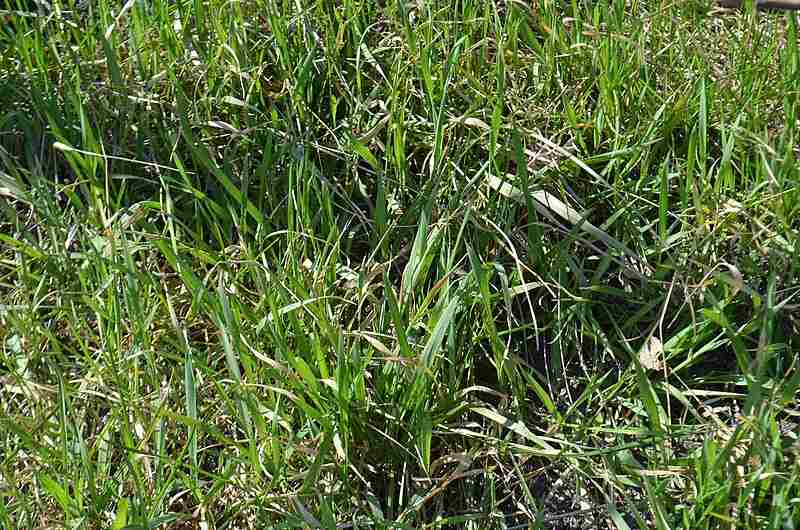
Photo Credit: Ethan2039 / Wikimedia Commons / CC BY-SA 4.0
Kentucky bluegrass is known amongst lawn care professionals for providing some of the most beautiful lawns in the region due to its dark green color and fine to medium leaf blades. It needs to be in full sun to thrive and is relatively sensitive. Kentucky bluegrass is commonly susceptible to diseases such as dollar spot, red thread, and rust.
This grass tends to grow aggressively, and because its growth stems from rhizomes, it can produce a substantial amount of thatch buildup. There are plenty of new releases of Kentucky bluegrass that are hybrid grasses consisting of a blend of both Kentucky and Texas bluegrass that stand up to heat much better than traditional Kentucky bluegrass.
Consider this type of grass if you are open to a moderate- to high-maintenance lawn.
- Classification: Cool-season
- Spreads by: Rhizomes
- Shade tolerance: Moderate; full sun is ideal
- Drought tolerance: Moderate
- Foot traffic tolerance: High
- Maintenance needs: High
- Mowing height: 2.5-3.5 inches
- Potential for disease: Moderate to high
Grass Seed Options:
– Jonathan Green (11970) Blue Panther Kentucky Bluegrass Grass Seed (3 lbs.)
– SeedRanch Midnight Kentucky Bluegrass Seed (5 lbs.)
– Jacklin Seed – Biltmore Blue Blend – 100% Kentucky Bluegrass (5 lbs.)
Perennial Ryegrass
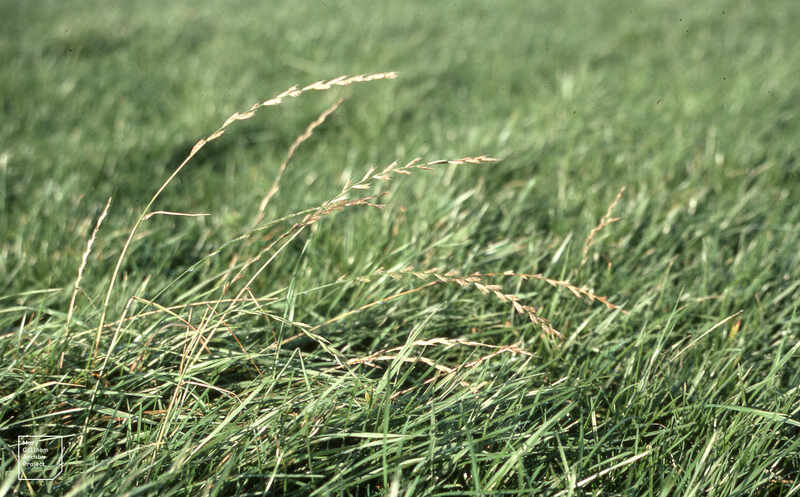
Photo Credit: Dr Mary Gillham Archive Project / Flickr / CC BY 2.0
Perennial ryegrass is a bunch-type grass that grows best in full sun and higher elevations. Mature perennial ryegrass may have excellent traffic tolerance but doesn’t fare well in heat and drought and is typically at significant risk of disease in warmer climates. It’s one of the fastest germinating cool-season grasses and establishes a dense canopy of turf quickly.
One of the most sought-after features of perennial ryegrass is its striping potential when it’s mowed. Want a green warm-season lawn year-round? This grass is also a great option for overseeding a Bermudagrass lawn so it has a green color throughout winter. It is ideal to grow perennial ryegrass in temperatures under 80 degrees since the potential for brown patch is high during warmer times of the year.
- Classification: Cool-season
- Spreads by: Bunch-type grass
- Shade tolerance: Low, full sun is best for this type of grass
- Drought tolerance: Low, grass is dormant in summer
- Foot traffic tolerance: High
- Maintenance needs: Low, grass type will need frequent cutting
- Mowing height: 1.5-2.5 inches
- Potential for disease: High
Grass Seed Options:
– Outsidepride Perennial Ryegrass Seed (5 lbs.)
– Eretz ProTurf Perennial Ryegrass Fine Lawn Seed (choose your size)
Warm-Season Grasses
Warm-season grasses prefer temperatures between 80–95 degrees Fahrenheit and have a winter dormancy period of three to five months, depending on where you’re located in the state. In Richmond, the number is typically closer to three months.
Compared to cool-season grasses, warm-season grasses have fewer pest problems and better water efficiency rates. They are also better suited to the summer season. The best time to establish a warm-season lawn around the state is mid-May through June.
Bermudagrass
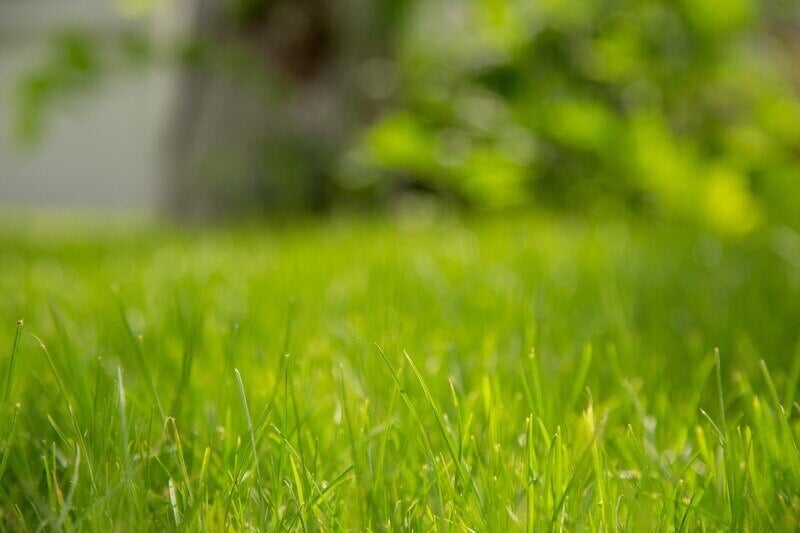
Photo Credit: Pexels
Lawn care professionals consider Bermudagrass a fantastic grass for lawns and one of the world’s most aggressive weeds. Bermudagrass grows so fast because its growth stems from stolons and rhizomes, which means it propagates underground and above ground.
As a result, it grows best in full sun and has tremendously poor shade tolerance. This is a wildly popular grass in the South because of its growing habits. However, it is a grass that will need to be mowed once a week.
- Classification: Warm-season grass
- Spreads by: Stolons and rhizomes
- Shade tolerance: Low
- Drought tolerance: High
- Foot traffic tolerance: High
- Maintenance needs: High
- Recommended mowing height: 1.5–2.5 inches
- Potential for disease: High, but it can tolerate diseases somewhat
Grass Seed Options:
– Pennington Bermudagrass Bare Spot (5 lb. bag)
– Pennington Smart Seed Bermudagrass Mix (8.75-lb. bag)
– Scotts Turf Builder Bermudagrass (10-lb. bag)
– Hancock Seed Co. Bermudagrass (50-lb. bag)
Zoysiagrass
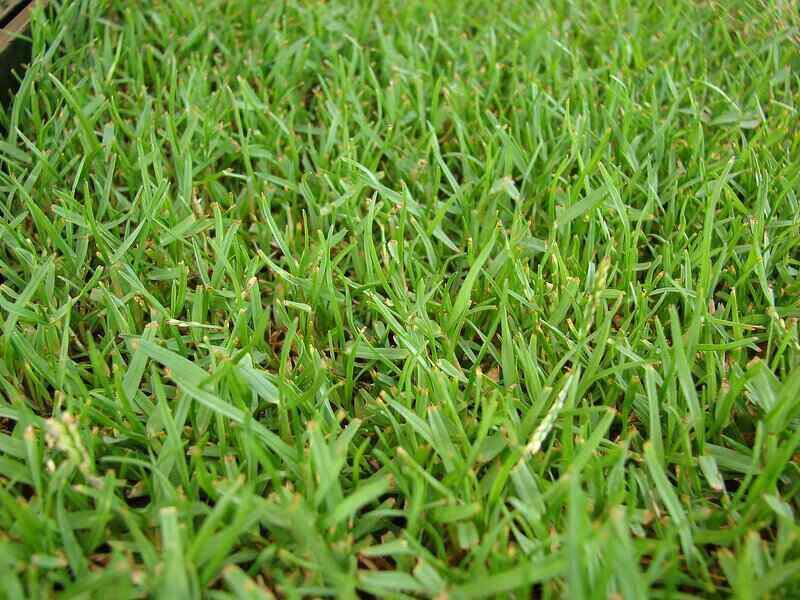
Photo Credit: Forest and Kim Starr / Wikimedia Commons / CC BY 3.0 US
Zoysiagrass is the most cold-hardy out of the warm-season grasses and isn’t likely to be damaged by a severe winter. Compared to Bermudagrass, Zoysiagrass is an extremely slow grower. Though not as drought tolerant as Bermudagrass, it has fewer pest problems and exceeds cool-season grasses in water efficiency rates. Its shade tolerance is low to moderate.
Another thing to note is that Zoysiagrass requires a sharp blade to get a high-quality, clean cut due to its density and texture. Consider this grass if you’re looking for a low-maintenance lawn that doesn’t need a lot of water.
- Classification: Warm-season grass
- Spreads by: Stolons and rhizomes
- Shade tolerance: Low to moderate
- Drought tolerance: High
- Foot traffic tolerance: High
- Maintenance needs: Low
- Recommended mowing height: 1-2 inches
- Potential for Disease: Low
Grass Plug and Seed Options:
– Zoysia Plugs (50 Large Grass Plugs)
– Zoysia Plugs (50 Full & Lush Grass Plugs)
– Zoysia Plugs (100 Plugs)
– Zoysia Emerald Grass Seeds (1/8 lb. of seeds)
– Zenith Zenith Grass Seeds (1/8 lb. of seeds)
St. Augustinegrass
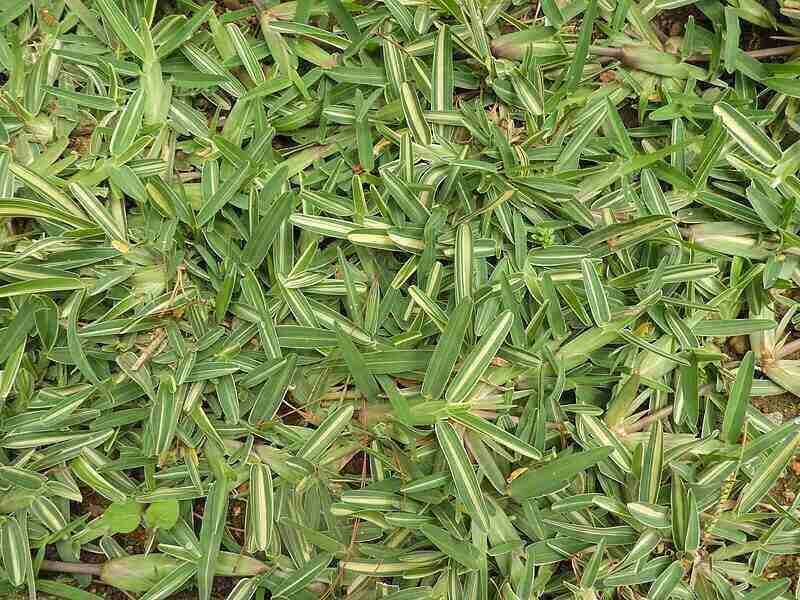
Photo Credit: Yercaud-elango / Wikimedia Commons / CC BY-SA 4.0
St. Augustinegrass’s growing habits are fast-paced and only well adapted to the Tidewater region in the state. So, it will do just fine in Richmond. It’s a moderate-density turf that rapidly spreads, but compared to the other warm-season grasses, it is more subject to insects and disease.
St. Augustinegrass also has the poorest cold tolerance out of this entire list. However, plenty of homeowners will testify that their St. Augustinegrass lawns haven’t been wiped out by a severe winter. So, consider this grass if you’re looking for an easy-to-repair, low-maintenance lawn that requires special attention to control insects and diseases.
- Classification: Warm-season grass
- Spreads by: Stolons
- Shade tolerance: Moderate
- Drought tolerance: Moderate
- Foot traffic tolerance: Moderate
- Maintenance needs: High
- Recommended mowing height: 3.5–4 inches
- Potential for disease: High
Grass Plug Options:
– Seed Ranch St Augustine Seville Grass Plugs (2 Trays)
– Seed Ranch St Augustine Floratam Grass Plugs (2 Trays)
How to Choose the Best Grass for Your Richmond Lawn
Heavy-Traffic vs. Low-Traffic Areas
Can your grass handle people and pets walking on it consistently?
Best grass types for high-traffic areas:
- Perennial ryegrass, Bermuda, Kentucky bluegrass, and Zoysiagrass
Best grass types for low to moderate traffic:
- Tall fescue and St. Augustine
Maintenance
Will your grass need a lot of attention and care?
High-maintenance grass:
- Bermudagrass, St. Augustine, Kentucky Bluegrass, and tall fescue
Grass with a low or moderate maintenance level:
- Perennial ryegrass and Zoysiagrass
Shade Tolerance
Can your grass thrive in partial shade, or must it have all the sun it can get?
Grass types that need full sun:
- Perennial ryegrass and Bermudagrass
Grass types that can thrive in partial shade:
- Zoysia, St. Augustine, Kentucky bluegrass, and tall fescue
Disease Resistance
Which grass is most resistant to disease, and which will be more susceptible?
Grass types with moderate to high disease resistance:
- Zoysiagrass and tall fescue
Grass types with low disease resistance:
- Kentucky Bluegrass, St. Augustine, Bermudagrass, and perennial ryegrass
FAQs
Yes and no. In many cases, it is ideal to mix different species of cool-season grasses with each other (tall fescue and Kentucky bluegrass, for example). However, it is not recommended to mix different species of warm-season grasses or to mix cool- and warm-season grasses. (Overseeding ryegrass into Bermudagrass over winter is an exception.)
Mixing Kentucky bluegrass and tall fescue, for example, will result in a stronger lawn and minimize disease and insect issues.
Once you plant your grass of choice, to make it spread faster, you should use fertilizer soon after planting it.
Adding nitrogen to your grass will keep it green. Also, planting grass that is less likely to form diseases in the transition zone will keep your grass green. Keep in mind that all grasses go dormant at some point. This is natural and doesn’t mean your grass is dead. If you want evergreen grass, consider planting ornamental grasses like liriope.
Do You Need Help Growing and Maintaining Your Grass?
Did you know that you don’t have to plant cool- or warm-season grasses yourself? Growing grass in Virginia’s transition zone is tricky, and sometimes it’s best to have an expert to guide you. Contact a Richmond lawn care pro today to hire someone to plant a new lawn for you and get it off to the best possible start.
LawnStarter participates in the Amazon Services LLC Associates Program, an affiliate advertising program. LawnStarter earns revenue from products promoted in this article.
Main Image Credit: Ubaid kareem / Wikimedia Commons / CC BY-SA 3.0